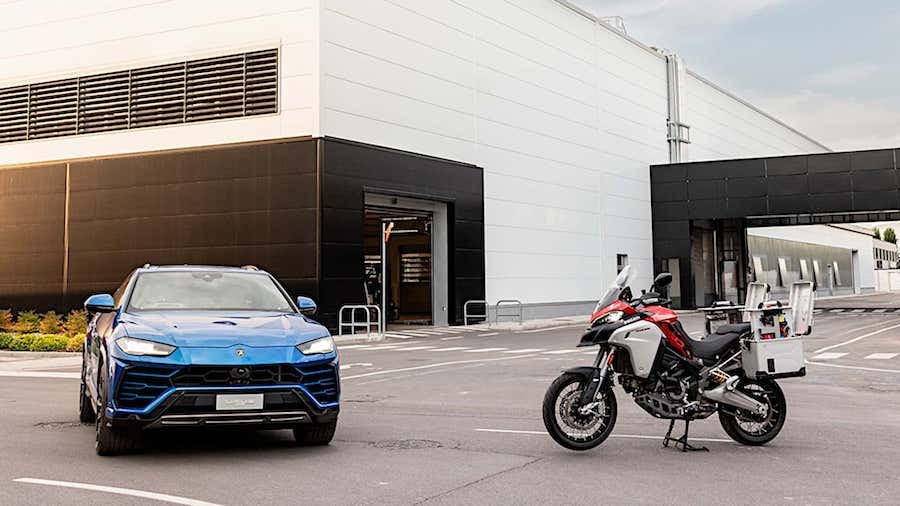Ducati And Lamborghini Demonstrate Connected Rider And Driver Tech

Remember the Connected Motorcycle Consortium (CMC)? It’s a group of motorcycle manufacturers including BMW, Ducati, Honda, KTM, Suzuki, Triumph, and Yamaha. In 2016, the group was originally formed to collectively analyze and address the prevalence of crashes between motorcycles and cars on public roads.
Fast forward to 2023, and Ducati just demonstrated a motorcycle and car connectivity system that it’s been working on with fellow Audi Group automotive manufacturer, Lamborghini. Advanced driver assistance systems (ADAS) have become more prevalent in cars over time, but finding the best way to integrate such systems and take motorcycles into account is a puzzle that Ducati and the greater CMC want to solve.
To prevent crashes between cars and bikes, quick reaction times are key. In this video, a Ducati Multistrada and a Lamborghini Urus demonstrate a communications system involving three crucial functions: Intersection Movement Assist, Left Turn Assist, and Do Not Pass Warning.
What Ducati and Lamborghini Demonstrated
To demonstrate Intersection Movement Assist, the scenario involved the Multistrada approaching an intersection where the view wasn’t completely clear from other perspectives around the intersection. Normally, if a bike is obscured from view by obstacles (trees, other vehicles, buildings, or simply poor municipal planning), other vehicles simply may not see them.
Depending on how cautious or incautious other vehicular traffic is, the risk of a crash increases in such a situation. However, with an electronic aid feature such as Intersection Movement Assist enabled on both the bike and the car, an alert is displayed on the car’s dashboard to let them know that the intersection isn’t clear. If the driver sees the warning, they will theoretically proceed more carefully into the intersection—or perhaps even wait to see the bike safely pass through.
Left Turn Assist functions similarly. I can’t tell you how many times I’ve seen or heard stories (both about riders I know and riders I don’t) who have had near misses because cars traveling in the opposite direction suddenly decide to turn left in front of the rider. If you ask the driver (or yell at the driver because they almost caused a huge crash), answers will usually range from a sheepish “sorry mate, I didn’t see you” to blaming you because how dare you have the audacity to be on a bike in the first place. Anyway, I digress.
With Left Turn Assist, the functionality here is that the connected electronic warning systems on the car and the bike allow the car to inform the bike that hey, I’m turning left. The rider should then be able to react in time to allow the driver to complete their turn and (again, theoretically) not endanger anyone. More on that later.
Finally, the Do Not Pass Warning is a scenario involving multiple vehicles that all talk to each other via their advanced electronic driver (and rider) communication systems. In this case, the scenario is a line of cars that are stopped (or at least significantly slowed) by the car at the front, which wants to turn left. If the cars and bikes are communicating, all the following vehicles can be warned not to pass, even if they can’t see the car up front that’s waiting to turn left.
Some Hurdles to Consider
Anything that can enhance road safety and the peaceful sharing of public roads between cars and bikes (and other road users) is, in our opinion, a good thing. If we’re going to have a suite of electronic driver (and rider) aids, then their having the ability to communicate useful data to one another seems like it could be positive.
However, there are some significant hurdles to consider. For one thing, it’s going to be a very long time before all vehicles on the road will have compatible communications systems that can share this information. Perhaps they never will. Some people like to drive old cars and ride old bikes, and that seems unlikely to change any time soon.
Also, both car and bike manufacturers tend to offer multiple trim levels on vehicles. Some people will buy the base model, and others will opt for the mid-tier or top-tier offerings—which are typically where the latest tech resides.
Unless governmental safety organizations mandate the use of connected safety systems like this—you know, like seat belts—that’s another potential failure point in forming a properly chatty intervehicle communication network on the road.
Finally, as anyone who’s been driving or riding for any length of time can tell you, people don’t always remember to use their turn signals. A connected vehicle system is only as good as the data it’s given, so if it doesn’t know that Driver A wants to turn left, then it can’t possibly inform other connected vehicles about Driver A’s plans.
Both drivers and riders sometimes do unexpected things—and fail to use turn signals 100 percent of the time. They’re human, and humans don’t always behave consistently, even if they’re well-meaning.
Still, some help is better than no help at all, and there’s no sense letting the perfect be the enemy of the good. Connected driver and rider systems can potentially be helpful, but it’s important that road users understand both their potential benefits and limitations so they can behave accordingly.
Related News


